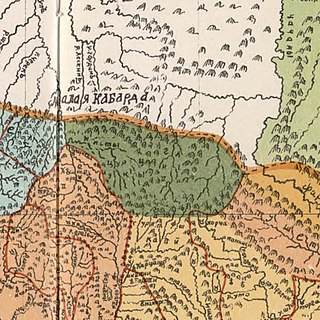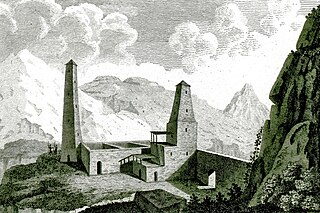You can help expand this article with text translated from the corresponding article in Russian. (September 2024)Click [show] for important translation instructions.
|
Egi-Chozh [a] is a ingush medieval castle complex.

You can help expand this article with text translated from the corresponding article in Russian. (September 2024)Click [show] for important translation instructions.
|
Egi-Chozh [a] is a ingush medieval castle complex.

The Egi-Chozh complex is located in the narrowest section of the gorge of Fortanga on the ridges of rocky branches of mountain ranges on both sides of the river. The choosing of the site was not accidental as it made the complex able to completely block the passage through the gorge. [1]
Four towers are located on the right bank of Fortanga and two are located on the left. The complex is also located near Dattykh, Ingushetia, Russia. [2]
In 1978, Egi-Chozh was studied by Dautova Rezeda. Previously it wasn't properly studied. [1]
Ingush, historically known as Durdzuks, Gligvi and Kists, are a Northeast Caucasian ethnic group mainly inhabiting the Republic of Ingushetia in central Caucasus, but also inhabitanting Prigorodny District and town of Vladikavkaz of modern day North-Ossetia. The Ingush are predominantly Sunni Muslims and speak the Ingush language.

When the Soviet Union existed, different governments had ruled the northern Caucasus regions of Chechnya and Ingushetia. Within the Mountain Autonomous Socialist Soviet Republic, later annexed into the Russian Socialist Federative Soviet Republic, they were known as the Chechen Autonomous Oblast and the Ingush Autonomous Oblast, which were unified on January 15, 1934, to form the Checheno-Ingush Autonomous Oblast. It was elevated to an autonomous republic as the Checheno-Ingush Autonomous Soviet Socialist Republic from 1936 to 1944 and again from 1957 to 1993. Its capital was Grozny.

Grozny Oblast was an administrative entity of the Russian SFSR that was established as Grozny Okrug on 7 March 1944 and abolished on 9 January 1957.

The Durdzuks, also known as Dzurdzuks, was a medieval exonym of the 9th-18th centuries used mainly in Georgian, Arabic, but also Armenian sources in reference to the Vainakh peoples.
The Mamilovs are an Ingush tribal organization/clan (teip). The clan comprises about 1,500 people. It is one of a few Ingush clans whose members share one name.

Simsim was either a historical region or kingdom in the North Caucasus during the Middle Ages, existing in the 14th century. Predominantly localized roughly in eastern Chechnya (Ichkeria), with some also connecting part of Kumyk Plain. Simsim is also localized in both Chechnya and Ingushetia. Its name may have been derived from the Chechen village of Simsir. However, according to folklore, the King Gayur-khan was chosen as the leader of all Chechens by the Mehk-Khel. In its later years it allied itself with the Golden Horde before being destroyed in 1395 by Timurlane, which was recorded in Zafarnama by Nizam al-Din Shami and the Zafarnama by Sharaf ad-Din Ali Yazdi.

Idris Murtuzovich Bazorkin was a North Caucasian writer, playwright, poet and statesman who mainly wrote his works in Russian but also in Ingush to a lesser degree. He had been recognized a classic of the Ingush literature during his lifetime.
My Checheno-Ingushetia was the regional anthem of the Chechen-Ingush ASSR.
The 255th Separate Chechen-Ingush Cavalry Regiment was a military unit of the Red Army during World War II which was active from 1942 to 1943.

Ghalghai is the self-name (endonym) of the Ingush people.

The Dzherakh, also spelled Jerakh, historically also known as Erokhan people, were a historical Ingush ethnoterritorial society, today a tribal organization/clan (teip), that was formed in the Dzheyrakhin gorge, as well as in the area of the lower reaches of the Armkhi River and the upper reaches of the Terek River.

The Timurid invasion of Simsim happened in the 14th century when the Timurid Empire invaded Simsim, an ally of the Golden Horde. As a result, Simsim was devastated which led to the collapse of the state; a large part of the population was killed and many shrines and temples were destroyed.

Fortanga historically sometimes referred as Balsu, is a river in North Caucasus that flows in Ingushetia and Chechnya. The length of the river is 69 km, the basin area is 526 km2.

Meredzhi is a non-residential rural locality in Galanchozhsky District of the Republic of Chechnya, Russia.

Khamkhi is an ancient city-settlement in Dzheyrakhsky District of Ingushetia. It is part of the rural settlement of Guli.

Falkhan is a rural locality in the Dzheyrakhsky District of Ingushetia, Russia. It is part of the Lyazhgi rural settlement.
Alkun is a rural locality in Sunzhensky District of the Republic of Ingushetia, Russia, located on both banks of the Assa River. It forms the municipality of the rural settlement of Alkun as the only settlement in its composition.

Maksharip Bagaudinovich Muzhukhoev was a Soviet and Russian historian, archaeologist.

Ingush towers are medieval Ingush stone structures used as residences, signal posts, and fortifications. Most are found in the Sunzhensky and Dzheyrakhsky Districts of Ingushetia, North Caucasia.
Djabrail Yurievich Chahkiev was a Soviet and Russian historian, archaeologist, weapons expert, ethnographer, archivist, candidate of historical sciences, Deputy Head of the State Archive Service of the Republic of Ingushetia.